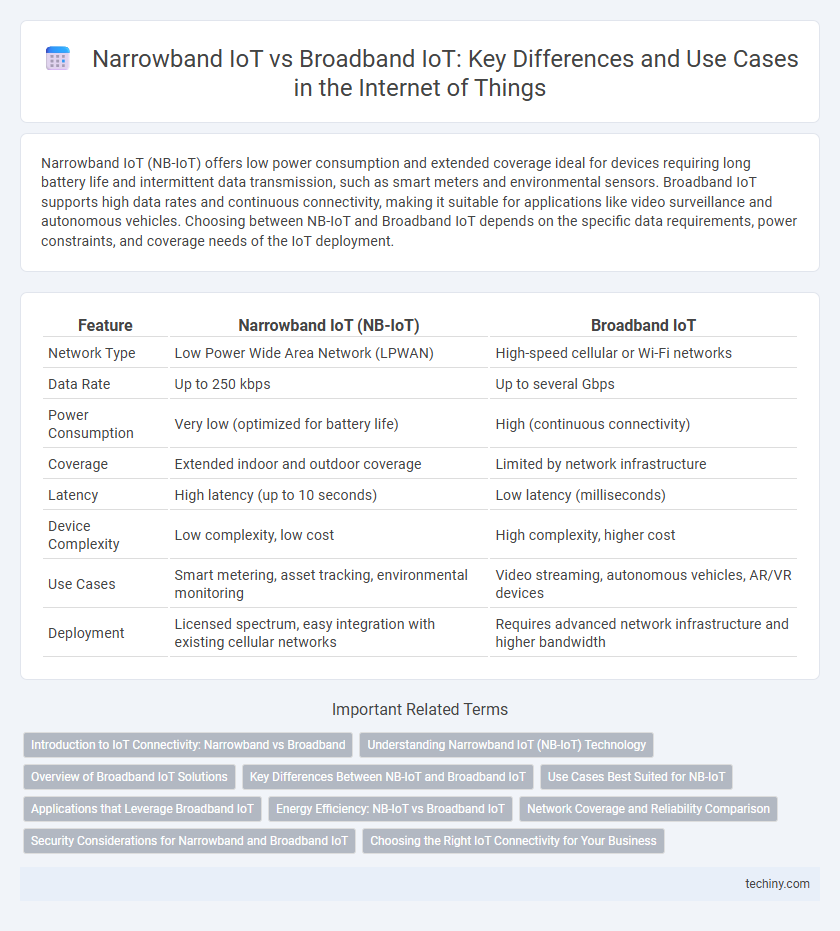Narrowband IoT (NB-IoT) offers low power consumption and extended coverage ideal for devices requiring long battery life and intermittent data transmission, such as smart meters and environmental sensors. Broadband IoT supports high data rates and continuous connectivity, making it suitable for applications like video surveillance and autonomous vehicles. Choosing between NB-IoT and Broadband IoT depends on the specific data requirements, power constraints, and coverage needs of the IoT deployment.
Table of Comparison
| Feature | Narrowband IoT (NB-IoT) | Broadband IoT |
|---|---|---|
| Network Type | Low Power Wide Area Network (LPWAN) | High-speed cellular or Wi-Fi networks |
| Data Rate | Up to 250 kbps | Up to several Gbps |
| Power Consumption | Very low (optimized for battery life) | High (continuous connectivity) |
| Coverage | Extended indoor and outdoor coverage | Limited by network infrastructure |
| Latency | High latency (up to 10 seconds) | Low latency (milliseconds) |
| Device Complexity | Low complexity, low cost | High complexity, higher cost |
| Use Cases | Smart metering, asset tracking, environmental monitoring | Video streaming, autonomous vehicles, AR/VR devices |
| Deployment | Licensed spectrum, easy integration with existing cellular networks | Requires advanced network infrastructure and higher bandwidth |
Introduction to IoT Connectivity: Narrowband vs Broadband
Narrowband IoT (NB-IoT) offers low power, wide-area connectivity ideal for devices requiring infrequent data transmission and long battery life, such as smart meters and environmental sensors. In contrast, broadband IoT leverages high-speed cellular networks like 4G and 5G to support devices demanding high bandwidth and real-time data exchange, suitable for applications like video surveillance and autonomous vehicles. Understanding the trade-offs between NB-IoT's energy efficiency and broadband IoT's speed is crucial for optimizing IoT connectivity strategies in diverse use cases.
Understanding Narrowband IoT (NB-IoT) Technology
Narrowband IoT (NB-IoT) technology is a low-power wide-area network (LPWAN) standard designed for efficient communication in IoT devices with minimal bandwidth requirements. NB-IoT operates in licensed frequency bands and offers extended coverage, deep indoor penetration, and long battery life, making it ideal for applications like smart metering, asset tracking, and environmental monitoring. Unlike broadband IoT, which supports high data rates for complex applications, NB-IoT prioritizes energy efficiency and connectivity stability over massive data throughput.
Overview of Broadband IoT Solutions
Broadband IoT solutions leverage high-speed cellular networks such as 4G LTE and 5G to support data-intensive applications requiring low latency and high bandwidth, ideal for video streaming, real-time analytics, and autonomous vehicles. These solutions facilitate seamless connectivity for smart cities, industrial automation, and augmented reality by enabling massive device deployment with enhanced data throughput. Broadband IoT architectures prioritize network scalability and reliability, ensuring robust performance in environments demanding rapid data exchange and continuous connectivity.
Key Differences Between NB-IoT and Broadband IoT
Narrowband IoT (NB-IoT) offers low power consumption and extended coverage ideal for devices requiring long battery life and minimal data transmission, such as smart meters and environmental sensors. In contrast, Broadband IoT supports high data rates and low latency applications, making it suitable for video surveillance and real-time data processing. The fundamental differences lie in network architecture, bandwidth usage, and targeted application scenarios, with NB-IoT optimized for massive machine-type communications and Broadband IoT designed for enhanced mobile broadband.
Use Cases Best Suited for NB-IoT
Narrowband IoT (NB-IoT) excels in low-power, wide-area network applications requiring extended battery life and deep indoor coverage, such as smart metering, environmental monitoring, and asset tracking. Its optimized bandwidth and low data rate make it ideal for devices that transmit small amounts of data infrequently. NB-IoT's cost-effective deployment and robust connectivity in challenging locations favor large-scale IoT projects with massive device density and minimal power consumption needs.
Applications that Leverage Broadband IoT
Broadband IoT powers applications requiring high data throughput and low latency such as smart cities, autonomous vehicles, and real-time video surveillance. It enables seamless connectivity for devices like connected cars and industrial robots that depend on fast, reliable internet access. This contrasts with Narrowband IoT, which is optimized for low power, low bandwidth use cases like sensor networks and asset tracking.
Energy Efficiency: NB-IoT vs Broadband IoT
Narrowband IoT (NB-IoT) significantly outperforms Broadband IoT in energy efficiency due to its low power consumption and optimized communication protocols designed for intermittent data transmission. NB-IoT devices leverage power-saving modes and extended discontinuous reception (eDRX) to achieve battery life spanning several years, ideal for long-term IoT deployments. In contrast, Broadband IoT requires higher power due to continuous connectivity and higher data throughput, making it less suitable for energy-sensitive applications.
Network Coverage and Reliability Comparison
Narrowband IoT (NB-IoT) offers superior network coverage with deep indoor penetration and extended range, making it ideal for remote or hard-to-reach locations. Broadband IoT, utilizing LTE or 5G networks, provides higher bandwidth and lower latency but may have limited coverage in rural or underground areas. NB-IoT ensures greater reliability for low-power, long-range applications, whereas Broadband IoT excels in high data throughput scenarios requiring consistent connectivity.
Security Considerations for Narrowband and Broadband IoT
Narrowband IoT (NB-IoT) leverages low-power, wide-area network technology with enhanced security protocols, including robust encryption and secure authentication tailored for constrained devices. Broadband IoT relies on high-speed networks that require advanced firewall protection and intrusion detection systems to mitigate increased exposure to cyber threats. Both technologies demand continuous security updates, but NB-IoT emphasizes lightweight security mechanisms to balance energy efficiency and data protection effectively.
Choosing the Right IoT Connectivity for Your Business
Narrowband IoT (NB-IoT) offers low power consumption, extended coverage, and cost-effective connectivity ideal for devices requiring infrequent data transmission, such as smart meters and environmental sensors. Broadband IoT supports higher data rates and lower latency, making it suitable for applications like video surveillance, autonomous vehicles, and real-time analytics. Evaluating factors like data volume, power efficiency, coverage needs, and operational costs ensures the optimal IoT connectivity choice tailored to specific business requirements.
Narrowband IoT vs Broadband IoT Infographic

 techiny.com
techiny.com